|
|
Home →
Survival →
Containers →
Baskets
Basket-making
Workshop
How to Make a Woven Basket
by Doc |
| |
| This is material designed to accompany a
basket-making workshop led by Doc for the Wildwood Trackers club on April 2,
2006. For photos of the workshop CLICK HERE.
Basic stages
- The base: made by forming a 'slath' with 6 strong, stoutish sticks.
These are bound together firmly and then a 'pairing weave', with fine
rods, is used to separate each base stick to form a spoked-wheel shape.
- The framework: long rods are inserted either side of each base stick
and bent upwards to form the framework of the basket.
- The upsett: the side stakes are held in place with a firm band of
upsett weaving known as 'waling'.
- The sides: various weaves can be used to build up the sides of the
basket, finishing with another band of waling.
- The border: at the required height the side stakes are bent over and
woven into a decorative edge.
It is important to remember the following points:
- the base sticks must be the stoutest;
- the side stakes should be both strong and pliable (especially at the
point where the border will begin);
- and the weavers should be the finest.
ALSO STRIVE FOR A TIGHT WEAVE! |
|
|
The base:
- Six base sticks, all of pencil thickness and about 12 in. long.
- Pierce holes through 3 of the base sticks.
- 'Slype' (sharpen) the tip ends of the unslit sticks.
- Thread a slyped stick through the pierced sticks, one at a time,
ensuring you alternate the 'tips' and 'butts'.
- Thread the other two sticks in a similar way, again ensuring that
you alternate the tips and butts. You now have a cross-shaped slath
- Insert the tips of 2 fine weavers
- Do 2 rows of 'pairing'
- Separate the base sticks into wheel-spoke shape and 'pair' (using
the finer rods first).
- Splice with a 'pairing join' (the new rod is placed to the left and
under the old end). Always match tip ends to tips and butt ends to
butts.
- Once wheel-spoke pattern is established, and when weavers run out,
join in one pair of weavers there, and one pair on the opposite side
(inserting trimmed tips under the previous row).
- 'Pick off' or trim the ends, cutting them diagonally so they rest
firmly against a stake and cannot slip through the gap.
- Finish the base with tips, taking the last strokes under the
previous row of weaving to stop them from unravelling.
- If necessary, secure the weaving temporarily by tying it across with
two pieces of thin string. Trim the base sticks level with the outside
edge.
- A slightly domed base will not wobble. You can encourage this shape
by bending it over your knee from time to time as you work.
|
The framework:
- Slype the butts of the side stakes. If you want the basket to have
vertical sides, slype on the 'belly' of the rod; if the basket is to be
more bowl-shaped, slype on the 'back'.
- Insert stakes on underside of base with cut-side uppermost.
- Turn over and 'prick up'.
- Gather up stakes, 2 at a time, from opposite sides. Tie together
with string.
|
| |
| The upsett: |
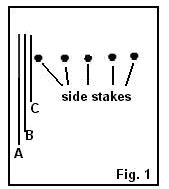 |
• Trim tips of 6 waling rods. Insert 3
of them to the left of one of the side stakes and the other 3 to the
left of the stake that is directly opposite. • Take the middle one
of the 3 rods (B) behind one stake and out to the front. Now pass
another rod (A) behind two stakes and out to the front. You now have
3 weavers coming through separate gaps. (See Fig. 1 and 2) |
|
|
|
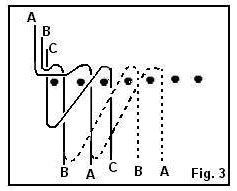 |
• Using the left-hand weaver (C), take
it in front of two stakes, behind one and bring it to the front.
Repeat this stroke, always using the new left-hand weaver. (See Fig.
3) • Each weaver should be firmly pulled down both at the back and
at the front on each stroke. Try to avoid a gap between the base
pairing and the side waling. |
|
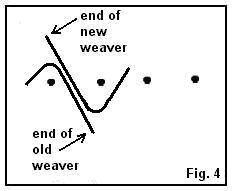 |
• When these groups of weavers run
out, join in the other six walers using a 'waling join'. Lay a new
rod beside and to the right of the old end, matching butts to butts
and tips to tips. (See Fig. 4) • As you wale these early rounds,
check that the stakes are being coaxed evenly into place and the
weaving is pressed down firmly. |
|
|
|
The sides:
- Join two weavers at the points where each group of waling rods
finished and work as before, with two groups on opposite sides.
- Rap the weave down gently after a few rounds.
- Finish the sides with another band of 3-rod waling. Rap down again.
|
| |
The border:
1. Make a kink in all the stakes over a piece of wood about twice the
diameter of the stakes at
this point. |
| |
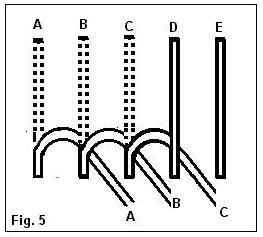 |
2. Carefully bend down stake A and
pass it behind stake B and out to the front. Repeat with
the next two upright stakes (B and C) to arrive at the position
shown in Fig. 5.The first few stakes that are woven in the border
must not be pulled too tight; there must be room to thread the last
stakes through them at the end of the border. This means LEAVE THEM
LOOSE - they can be pulled tighter when border finished.
|
|
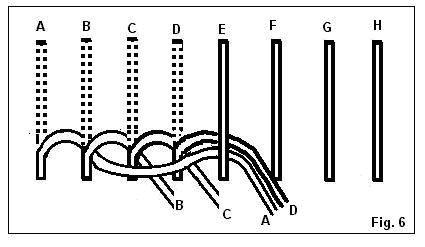 |
3. Take the left-hand one of the 3
stakes (A) and pass it loosely in front of the upright stake
(D), behind the next (E) and then back out to the front. Now bend
the left-hand upright
stake (D) down so that it lies flat beside stake A as in Fig. 6. |
|
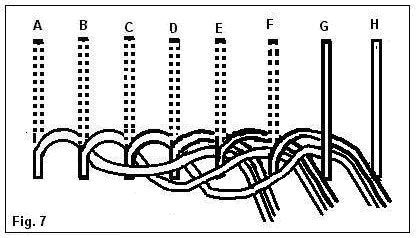 |
4. Repeat step 3 with the other two
sets of stakes (B and E) and (C and F), so that you have 3
pairs of stakes in front. (See Fig. 7) |
|
5. Ignore the left-hand stake (A) of the
left-hand pair (this will be picked off later) and taking
the right-hand one (D), repeat step 3. Carry on in this way around the
basket, always using
the right-hand rod of the left hand pair. (See Fig. 8) |
|
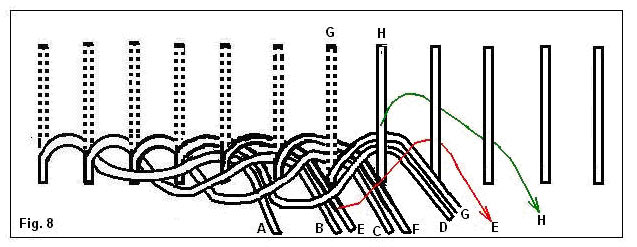 |
| |
| Finishing off: When there is only one
vertical stake left, the final horizontal rods have to be threaded into
place. This can be tricky to do at first without kinking the rods badly.
Before working the rods through this final stage it may be necessary to
soften them by firmly running them through finger and thumb.
1. When only one upright stake remains weavers will be arranged as shown
below. (Fig. 9) |
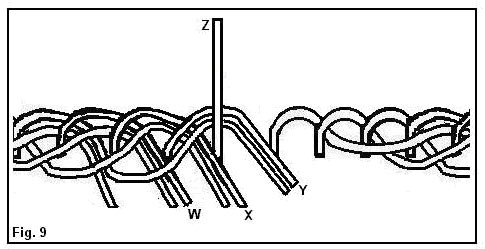 |
| 2. Ignore the left-hand rod of the left-hand
horizontal pair and take the right-hand one (W) in front of the upright
stake (Z) and back through the loop made by the first rod that was bent down
(A). The final upright rod (Z) is then threaded beside it. |
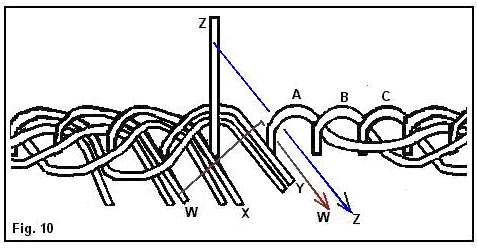 |
| 3. Again ignoring the left-hand rod in each of
the final 3 pairs, finish by taking each right-hand rod (X,Y and Z) in front
of two stakes and behind one before threading it through into the pattern.
(When threading it through into the pattern, make sure it goes to the left
of the rod it sits beside.) |
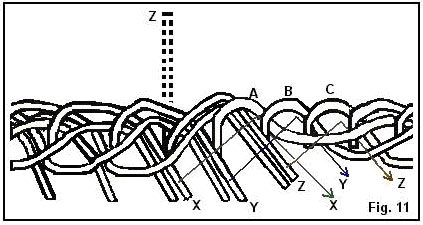 |
| 4. Finally, when all the weavers have been
inserted and the border is as illustrated, trim all the ends. Make neat,
diagonal cuts and ensure that each end lies against an upright stake. This
final operation is called 'picking off'. |
| |
|
|
|
|